North America News
U.S. Stock Indexes End Mixed; Weekly Losses Modest
U.S. markets wrapped up the day with mixed results and posted slight losses for the week.
- Dow Jones: Dropped 119.07 points (-0.29%) to close at 41,249.38
- S&P 500: Slipped 4.03 points (-0.07%) to 5,659.91
- NASDAQ: Gained 0.78 points (flat) to end at 17,928.92
- Russell 2000: Fell 3.34 points (-0.16%) to 2,023.07
For the week:
- Dow: -0.16%
- S&P 500: -0.47%
- NASDAQ: -0.27%
- Russell 2000: +0.11%
Markets showed caution as traders weighed economic uncertainty, geopolitical tensions, and upcoming U.S.-China trade talks.

Nippon Steel Still Pushing to Acquire U.S. Steel
Nippon Steel says it hasn’t changed course on its plan to acquire U.S. Steel, despite ongoing political hurdles. Negotiations with the U.S. government continue, with the Committee on Foreign Investment in the United States (CFIUS) expected to offer a recommendation by May 21. Former President Trump, now expected to decide by June 5, has expressed opposition, stating, “we don’t want to see it go to Japan.”
Fed’s Barr: Monetary policy is in a good position to adjust as conditions unfold
- Remarks by Fed governor, Michael Barr
- Economic outlook clouded by trade politics that have increased uncertainty
- Tariffs to lead to higher US inflation, lower growth starting later this year
- Fed may be in a difficult position if both inflation and unemployment rise
- Equally concerned tariffs will lead to higher unemployment as economy slows
- Tariffs could create persistent upward pressure on inflation by disrupting supply chains
- Too soo to know how tariffs will affect the economy
- Fair to say that uncertainty around tariffs have raised risks to higher inflation, lower growth
- Growth has been strong over the last year and remains so today
Fed’s Barkin: Tariffs to lead to higher inflation and lower growth in US and abroad
- Comments from the Richmond Fed President
- Tariffs to lead to higher inflation and lower growth in US and abroad.
- Trump tariffs are without modern precedent.
- Given economic strength, monetayr policy is in a good position.
- I’m concerned that tariffs will lead to higher unemployment.
- Economic outlook clouded by trade policies that have increased uncertainty, hurt consumers and business sentiment.
- Consumer spending and business investment still very solid
- DC weekly restaurant spending and job openings are down
Fed’s Kugler: The US labour market is stable, close to maximum employment
- Comments from Fed’s policymaker, Adriana Kugler
- The US labour market is stable, close to maximum employment.
- Past two recoveries suggest 3.5% unemployment sustainable.
- Our policy right now is moderately restrictive.
- The labour market is stable and has been resilient.
- Q1 GDP showed the real side of the economy is resilient.
- Scenarios are important amid high degrees of uncertainty.
- Retail sales showed some front loading.
- There could be some pullback in consumer spending.
- Important to keep long-run inflation expectations stable.
- I see some upside risk to inflation from tariffs.
- The economy has been resilient so far.
- Economic health gives the Fed time to make progress on inflation.
- It’s unclear how tariff policy will shake out.
- Unclear how tariffs policy will shake out
- See some upside risk to inflation from tariffs
- Economy has been resilient so far
- Economic health gives Fed time to make progress on inflation
Fed’s Williams: Now is a time of great uncertainty and change
- Comments from the New York Fed President Williams
- Now is a time of great uncertainty and change.
- Central bank independence delivers better outcomes.
- Expect growth to slow considerably, inflation and unemployment higher.
- We are focused on keeping inflation as close to target as possible.
- Key to think in scenarios in times of uncertainty.
- Factors keeping the long-run neutral rate low are still in place.
- I still see the long-run neutral rate as quite low.
- The markets are very focused on downside risks at the moment.
- Markets appear convinced Fed will get inflation back to 2%.
- Now is an inflection point between hard and soft data.
- Hard data is telling us the economy is good right now.
- The next few quarters will help illuminate economy’s state of affairs.
- The labor market has proved to be resilient
- We want to get an idea of what the tariff policies will be
- Things are in a good place
- It’s hard to speculate what the Fed will do
- If the economy weakens more than expected it would call for deeper rate cuts
- The details on tariffs do matter for the economic impacts
- Trade policies are very-much in flux
- The US consumer never lets us down
- There was some front-loading ahead of tariffs
- Monetary policy is modestly restrictive right now
U.S. Treasury Launches ‘Known Investor’ Fast Track for Allies
The U.S. Treasury is piloting a new program to streamline foreign investment from partner countries. The “Known Investor” portal will allow vetted investors to submit information to CFIUS ahead of formal filings, speeding up the review process.
This initiative supports the America First Investment Policy by encouraging safe, stable investments while safeguarding national security. Treasury Secretary Scott Bessent emphasized its importance for attracting trusted capital and enhancing transparency.
Tesla Cancels Cybertruck Range Extender Battery
Tesla has dropped its plan to offer a $16,000 range extender for the Cybertruck. Originally slated for release in early 2025—later delayed to mid-year—the accessory would have extended range to 470 miles (eventually revised to 445 miles), but required giving up half the truck bed.
The company has confirmed it will issue refunds to those who placed deposits. Issues with practicality and utility appear to have led to the decision.
Canada Adds 7.4K Jobs in April, Unemployment Edges Up
Canada added 7,400 jobs in April, beating expectations of 2,500, though the unemployment rate ticked up to 6.9% from 6.7%. Full-time jobs surged by 31.5K, while part-time roles fell by 24.2K. Manufacturing jobs dropped by 31K. The participation rate edged up to 65.3%, and wages for permanent employees held steady at 3.5% y/y. Total hours worked rose 0.4% month-over-month and were up 0.9% from a year earlier.

Commodities News
Gold Jumps Over 1% as Dollar Weakens, Global Tensions Rise
Gold rallied more than 1% Friday, buoyed by a weaker dollar and rising global risk aversion. As U.S. Treasury yields declined, the appeal of non-yielding assets like gold increased. At last check, gold was trading at $3,338 per ounce.
The U.S. Dollar Index (DXY) fell 0.32% to 100.31, reversing two days of gains. Traders are positioning for possible fallout from escalating geopolitical flashpoints and key trade negotiations between the U.S. and China scheduled for Saturday in Switzerland.
Adding fuel to risk-off sentiment, President Trump floated an 80% tariff on Chinese goods, intensifying uncertainty. Meanwhile, border tensions between India and Pakistan escalated, with accusations of artillery and drone use on both sides.
Central banks continued building reserves:
- PBoC added 2 tonnes in April
- Poland’s NBP increased by 12 tonnes
- Czech National Bank added 2.5 tonnes
Markets are also pricing in a 25 bps Fed rate cut in July, with two more cuts expected before year-end.
China’s Copper Ore Imports Hit Record High
China’s copper ore imports surged to a record high in April, signaling strong demand despite a recent dip in refined copper imports, according to Commerzbank’s Thu Lan Nguyen.
Chinese producers appear to be ramping up domestic processing as ore imports climb, even as refining charges remain low—suggesting tight ore supply globally. This shift may worsen ore availability outside China, potentially amplifying China’s dominance in global copper production.
Chile, the world’s top copper supplier, offered a slight reprieve. Its largest producer recently ramped up output after years of underperformance due to operational issues.

U.S. and Canadian Rig Counts Both Drop by 6
Baker Hughes reported a drop of 6 rigs in both the U.S. and Canada. The U.S. count now sits at 578—down 25 from last year—with oil rigs down 5 to 474, gas rigs unchanged, and miscellaneous rigs down 1. Offshore rigs in the U.S. also declined by 3 to 11.
In Canada, the total rig count stands at 114, with oil rigs falling by 6 to 68. Compared to last year, Canada’s count is down 2 overall, with gas rigs down by 10 despite an increase in oil rigs.
U.S. Crude Oil Ends Week at $61.02, Up 1.85%
U.S. crude futures closed at $61.02 per barrel, up $1.11 or 1.85% on the day. The weekly gain was 4.46%, helped by a sharp recovery from an earlier low of $55.39—just above the year’s low of $55.15. The intraday range stretched from $59.92 to $61.42.
EIA Cuts U.S. Oil Production Forecast
The U.S. Energy Information Administration (EIA) has lowered its outlook for domestic oil output, citing falling prices and reduced drilling activity. The revised forecast now expects U.S. production to rise by just 200,000 barrels per day (bpd) this year.
Peak production is forecast to hit 13.7 million bpd in December, then slide to 13.44 million bpd by end-2026. Some shale producers have already begun pulling back on spending, particularly in the Permian Basin. One executive described the downturn as a “dramatic decline in business,” signaling an earlier-than-expected output drop.
China’s Crude Oil Imports Stay Elevated in April
Chinese refiners continued to stock up on crude in April, importing 11.7 million bpd, according to customs data. Though slightly lower than March’s record levels, imports were up 7.5% year-over-year, boosted by a drop in global prices.
Data provider Vortexa estimates stockpiling in April exceeded 1 million bpd, suggesting inventory building was a strategic move. Imports from Iran also stayed strong at around 1.5 million bpd.
That pace may not hold. The U.S. has stepped up enforcement, adding more Chinese independent refineries to its sanctions list over their Iranian oil purchases. Another refinery was sanctioned just this week.
Europe News
German DAX Hits Record; Spain’s Ibex at Highest Since 2008
The German DAX closed at a new record of 23,489.43, up 0.59% on the day. Spain’s Ibex also made headlines, finishing at 13,554.09—its highest level since June 2008. Other major European indices also advanced:
- France’s CAC: +0.64% at 7,743.76
- UK’s FTSE 100: +0.27% at 8,554.81
- Italy’s FTSE MIB: +1.02% at 39,370.00
Weekly performance was mixed: DAX +1.79%, Ibex +0.80%, CAC -0.34%, FTSE 100 -0.48%, FTSE MIB +2.72%.

BoE’s Bailey: Our commitment to the 2% inflation target is unwavering
- Bank of England Governor Bailey speaking
- Our commitment to the 2% inflation target is unwavering.
- It is good we have a diversity of views on MPC.
- We will use scenarios as vehicles for exploring risks around the baseline and accomodating differences of views on the committee.
- The latest choice of BoE scenarios does not mean inflation risk skewed in one direction.
- We are on course to put inflation surge firmly behind us.
- Global economic environment is likely to continue to be challenging and less predictable that it was in the past.
- UK-US trade deal will leave effective tariff rate higher than where they started.
- UK-US Trade Deal ‘Good News’.
- Economic impact of tariffs on UK depends a lot on what rest of the world agrees with the US.
- We are putting quite a bit of weight on forward-looking survey evidence showing easing wage inflation.
BOE’s Pill: Not seeing a dramatic shift in the UK economy after tariff announcements
- As a reminder, Pill dissented against the rate cut yesterday as he voted to keep the bank rate unchanged
- Limited economic reaction to tariffs partly reflects expectations of looser BOE policy
- Should not neglect longer-term upward pressures on inflation from wages
- “Careful” rate cuts should be understood to represent being alert, agile to economic changes
- There is still some way to go on disinflation
ECB’s Simkus: Eurozone inflation depends on EU retaliation to the US
- Remarks by ECB policymaker, Gediminas Šimkus
- Eurozone inflation depends on EU retaliation to the US.
- Geopolitics since the starts of the year is bad news for the economy.
- There is downward pressure on inflation.
- Need to watch for China goods rerouting to Europe.
- ECB June projections may be a little bit worse.
- June ECB cut is needed.
- There is no central scenario for ECB rates.
- It’s unclear if a post-June cut will be in July or September.
- We are more or less there on inflation.
- Quite high chances we’ll be undershooting on inflation.
Swiss president: Switzerland should be one of the next countries for US deal
- Comments from President Keller-Sutter
- Talks with Americans encouraging
- Have the impression the US is looking for tailor-made solutions with countries
- Pause on tariffs not to be lifted during negotiations
- Today the American side ‘clearly committed’ to accelerating talks
- Switzerland does not subsidize industry, but other countries may, these are the points the US is interested in
- Switzerland is now in a group of countries that are now treated swiftly
Goldman Sachs No Longer Predicts June Rate Cut by BoE
Goldman Sachs has changed its outlook for the Bank of England, now expecting it to hold rates steady in June instead of cutting by 25 basis points. The firm still anticipates rate cuts at every meeting starting in August, eventually reaching a terminal rate of 2.75% by March 2026.
Asia-Pacific & World News
China Tells U.S. to Play by Trade Rules
Ahead of a key round of trade discussions, China’s Foreign Ministry reiterated that Washington must respect established international trade norms. As the weekend talks approach, speculation is mounting over whether the U.S. might lower tariffs as a gesture before negotiations officially begin.
PBOC Pledges Flexible, Supportive Monetary Policy
China’s central bank has reaffirmed its commitment to maintaining a moderately loose monetary stance. The PBOC said it will ensure ample liquidity, boost domestic demand, and manage expectations. The bank also pledged to keep inflation stable, improve interest rate mechanisms, and support a balanced, stable yuan exchange rate.
China’s Export Growth Beats Expectations Despite Tariffs
From January to April, China’s exports in yuan terms rose 7.5% compared to last year, while imports dropped 4.2%. April alone saw a 9.3% jump in exports, down from 13.5% in March but still a strong showing under ongoing tariff pressure. Imports for the month ticked up 0.8%, rebounding from a 3.5% decline previously.
In dollar terms, exports during the first four months of 2025 rose 6.4%, while imports slid 5.2%. The overall trade surplus reached $368.76 billion, including a $97.07 billion surplus with the U.S.
For April, dollar-denominated exports climbed 8.1% year-over-year; imports fell slightly by 0.2%. The monthly trade balance came in at a $96.18 billion surplus, including a $20.46 billion surplus with the U.S.
China’s Deputy FM: No Fear in Facing U.S. on Trade
Vice Foreign Minister Hua Chunying delivered a firm message ahead of trade talks, stating China isn’t afraid of confrontation if necessary. She criticized U.S. trade policy as unsustainable and reiterated Beijing’s confidence in weathering external pressure.
Hua stressed that China prefers peaceful relations but won’t back down from defending its interests. She also pointed out that most Chinese citizens don’t want a trade conflict but remain confident in the country’s ability to navigate one.
SMIC Sees Sales Dip as Trade Tensions Cloud Outlook
China’s largest semiconductor maker, SMIC, warned of weakening demand and a potential 6% revenue drop for Q2. While U.S. tariffs briefly boosted some orders, Co-CEO Zhao Haijun said the gains were limited.
The company remains vulnerable to the broader fallout from U.S.-China trade tensions and shifts in global supply chains. Investor focus is now turning to what this could mean for the broader semiconductor landscape in China.
China May End Home Pre-Sales to Rein in Market Risk
Beijing is considering a major change in real estate policy—banning pre-sales of homes and requiring developers to sell only completed units. The goal: stabilize the market, reduce risks, and address public frustration over unfinished projects.
This new framework would apply only to new land deals and exclude public housing, with flexibility for local governments to implement. While it could help reduce oversupply and debt burdens, analysts warn it may squeeze developer cash flow and slow down new investments.
Sales of new homes by top developers dropped 8.7% in April from a year earlier, reinforcing the urgency for reform. The central government plans to expand completed-home sales nationally in 2025, building on pilot programs already running in over 30 cities.
China Turns to Argentina for $900M in Ag Purchases
In a move signaling its shift away from U.S. agricultural imports, China is planning to buy roughly $900 million worth of soybeans, corn, and vegetable oil from Argentina. According to Bloomberg, the agreement is based on a non-binding letter of intent between China and Argentine exporters.
This pivot highlights how the trade conflict with Washington is reshaping supply chains.
PBOC sets USD/ CNY reference rate for today at 7.2095 (vs. estimate at 7.2581)
- PBOC CNY reference rate setting for the trading session ahead.
PBOC injects 77bn yuan via 7-day RR, sets rate at 1.4%

Westpac Predicts Double Rate Cuts from RBNZ
Westpac now expects the Reserve Bank of New Zealand to slash interest rates twice—once in May and again in July, each by 25 basis points. Despite the forecast, the New Zealand dollar remained steady, trading near 0.5902 against the U.S. dollar.
Japan’s Economic Indicators Weaken in March
Japan’s leading index slipped to 107.7 in March, down from 108.2 the previous month, according to the Cabinet Office. The coincident index also fell to 116.0 from 117.3. Despite the declines, officials maintain the assessment that the index is “halting to fall,” suggesting no clear trend reversal yet.

Japan Household Spending Surges Past Forecasts
Japanese households spent 2.1% more in March compared to a year earlier, blowing past expectations of just a 0.2% increase. On a monthly basis, spending was up 0.4%, beating projections of a decline.
A government spokesperson noted early signs of recovery in consumer behavior but said many are still cautious about spending on food.
Japan Wage Growth Slows, Real Wages Drop Again
March wage data from Japan showed overall earnings up 2.1% year-over-year, falling short of the expected 2.3% and down from February’s 3.1%. Overtime pay—a key indicator of economic momentum—dropped 1.1%, the steepest decline in nearly a year.
Real wages, adjusted for inflation, fell 2.1%, marking the third straight monthly decline.
Crypto Market Pulse
BTC Holds $103K as Altcoins Steal the Show
Bitcoin held steady near $103,000 despite $117 million in fresh ETF inflows, while altcoins took the spotlight. The total crypto market cap rose to $3.37 trillion, with ETH, SOL, and DOGE posting strong gains.
- ETH: Up 6% to $2,490; weekly gain 25.6%
- SOL: Up 4.7% daily, 19.6% for the week
- DOGE: Jumped 7.7% to $0.2145, with weekly gains nearing 20%
Investors appear to be rotating out of BTC and into altcoins. PEPE was the week’s top meme coin, soaring 40.4%.
Meanwhile, Metaplanet raised $21 million in zero-interest bonds to buy more Bitcoin. And in Germany, authorities seized $38 million in crypto assets from the anonymous eXch platform amid a broader investigation into alleged money laundering activities.
Ethereum Logs Biggest Daily Gain in 4 Years
Ethereum jumped 21.8% on Thursday—its largest single-day rally since May 2021—closing at $2,330. The move was driven by crypto-native spot investors pulling 180,000 ETH from exchanges. The rally continued Friday, pushing ETH up 6% to cap a 29% weekly gain.
Technical indicators show ETH could soon test $2,500 and $2,850 if momentum holds. Institutional players like Abraxas Capital also contributed to the rally, withdrawing over 138K ETH in two days. Sentiment spiked after Ethereum’s Pectra upgrade and leadership changes at the Ethereum Foundation.

Brazil’s B3 Exchange to Launch ETH, SOL Futures in June
Brazil’s B3 Exchange will begin trading Ethereum and Solana futures on June 16. The contracts, priced in USD and benchmarked to Nasdaq indices, have been approved by Brazilian regulators. ETH contracts will be issued in 0.25 lots and SOL in 5-unit contracts.
In a move to attract retail investors, B3 is also reducing its Bitcoin futures contract size to 0.01 BTC. Product head Marcos Skistymas said the new offerings reflect rising demand for crypto exposure through regulated, innovative instruments.
Standard Chartered Ups Bitcoin Forecast, Says $120K Was Too Low
Standard Chartered now believes its $120,000 Bitcoin target for Q2 might be too conservative. The bank sees even higher prices ahead, citing a surge in investment flows and a shift in investor strategy.
Key drivers include $5.3 billion in recent inflows to U.S. Bitcoin ETFs, stronger accumulation by institutional investors, and increased exposure from sovereign wealth funds like Abu Dhabi’s. The Swiss National Bank is also reportedly holding shares in MicroStrategy, a proxy for Bitcoin.

The Day’s Takeaway
Day’s Takeaway: Key Market Trends & Developments
United States
- Markets Mixed, Weekly Losses Modest:
U.S. indices ended the day unevenly. The Dow fell 0.29%, the S&P dropped 0.07%, while the NASDAQ was flat. The Russell 2000 dipped 0.16%. For the week, the Dow lost 0.16%, S&P dropped 0.47%, and the NASDAQ slipped 0.27%. The Russell 2000 was the lone gainer, up 0.11%.
Canada
- Jobs Surprise to Upside, But Unemployment Ticks Higher:
Canada added 7.4K jobs in April, beating the 2.5K forecast. Full-time employment surged by 31.5K, while part-time fell sharply. The unemployment rate rose slightly to 6.9%, and manufacturing lost 31K jobs. Participation rose to 65.3%. - Wage Growth Holds Steady:
Average hourly wages for permanent employees held at 3.5% y/y, unchanged from March. Total hours worked rose 0.4% for the month and 0.9% year-over-year.
Commodities
- Gold Climbs as Dollar Falls and Risks Mount:
Gold’s rally to $3,338 followed a DXY dip to 100.31 and falling U.S. yields. Tensions between India and Pakistan, plus fresh Trump tariff threats, added to safe-haven buying. The PBoC, Poland, and Czech Republic all increased gold reserves in April. - Copper Ore Imports in China Hit All-Time High:
China ramped up copper ore imports even as refined copper inflows eased. The move supports domestic production but raises global supply concerns. Chile’s biggest copper miner also reported improved output. - Crude Oil Imports Strong in China Despite U.S. Sanctions:
China imported 11.7 million bpd of crude in April, up 7.5% from last year. Imports from Iran remained high at 1.5 million bpd. The U.S. added more Chinese refiners to its sanctions list over these purchases. - U.S. Oil Output Forecast Cut by EIA:
The EIA slashed its production outlook, now seeing just a 200K bpd increase in 2025, peaking at 13.7M bpd by December. The decline may come sooner, as shale drillers pull back on activity due to low prices and demand concerns.
Europe
- Germany’s DAX Sets Record; Spain Hits 2008 High:
The DAX closed at 23,489.43, a record high. Spain’s Ibex finished at 13,554.09, its best level since 2008. The FTSE MIB (Italy) climbed over 1% on the day. Weekly moves were mixed across the continent, with Germany and Italy up and France and the UK slightly down.
Asia
- Japan Economic Indicators Weaken:
Japan’s leading index dropped to 107.7 from 108.2, and the coincident index fell to 116.0 from 117.3. Despite the slide, the government’s view remains unchanged, describing the trend as “halting to fall.” - China’s Copper and Crude Demand Still Strong:
Strong copper ore and oil import figures reinforce China’s continued demand for industrial inputs. These trends support domestic production but may disrupt global supply chains. - PBOC Maintains Easy Policy Stance:
China’s central bank reiterated its commitment to a “moderately loose” monetary policy, pledging to maintain liquidity, support demand, and stabilize the yuan. - Trade Talk Rhetoric Heats Up:
Ahead of weekend talks, China urged the U.S. to respect international trade rules. Trump’s tariff threats have raised the stakes significantly.
Rest of the World
- India–Pakistan Conflict Escalates:
Tensions on the border are rising with both sides accusing each other of deploying drones and artillery. This has helped drive risk-off sentiment and demand for gold. - Chile’s Copper Output Improves:
Chile’s top copper miner has increased production after a period of underperformance. The move could ease pressure on global supply, which has been strained by surging Chinese demand.
Cryptocurrency
- Bitcoin Holds Firm Above $103K, But Rally Pauses:
BTC traded as high as $104,361 before stalling. The rally could take a breather before pushing toward the key $110K level. Price support sits near $100K. - ETH Posts Biggest Daily Gain in 4 Years:
Ethereum soared 21.8% Thursday and added another 6% Friday, closing in on $2,500. The spike came as 180,000 ETH was withdrawn from exchanges by investors. - Crypto Market Cap Surges on Altcoin Strength:
The global crypto market hit $3.37 trillion, driven by gains in ETH, SOL, DOGE, and meme coins like PEPE, which soared 40.4% this week. - Brazil’s B3 to Launch ETH and SOL Futures in June:
Starting June 16, Brazil’s top exchange will offer USD-settled futures contracts for Ethereum and Solana, with approval from the country’s securities regulator. - Metaplanet Buys More BTC via Bond Sale:
The firm raised $21.25 million in a zero-interest bond sale to fund additional Bitcoin purchases, reinforcing its long-term crypto strategy. - Germany Seizes $38M in Crypto from eXch Platform:
Authorities shut down the anonymous exchange, accusing it of facilitating $1.9B in illicit transactions, some linked to North Korean hackers.

















